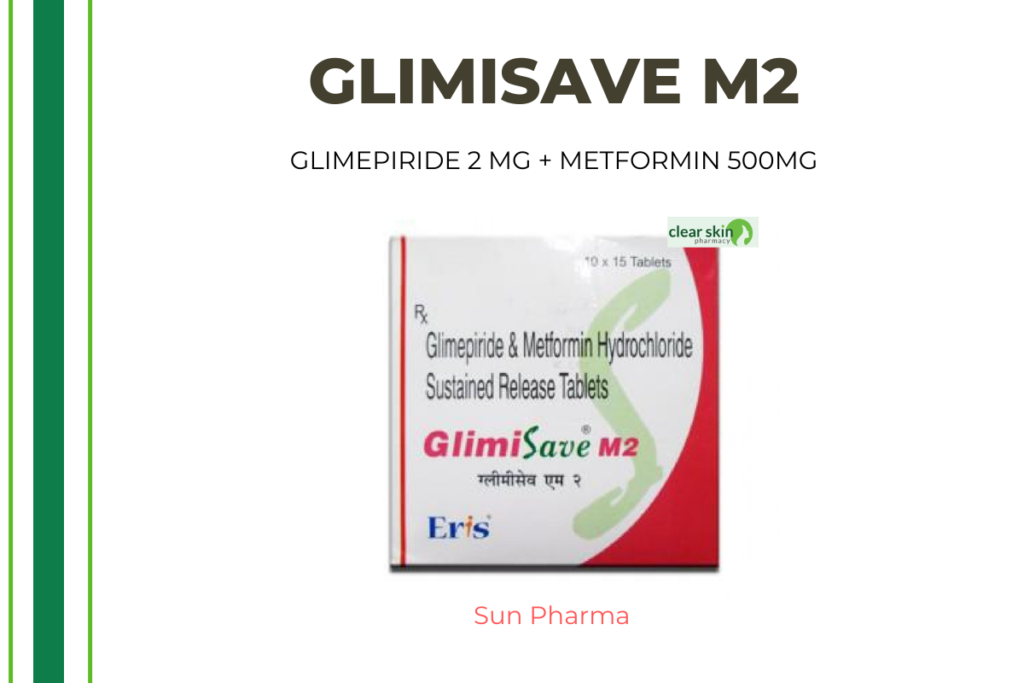Glimisave M 2
Glimisave M 2 comprises Glimepiride and Metformin, two anti-diabetic medicines. Glimepiride is a sulfonylurea that increases insulin production by the pancreas. Metformin, a ‘biguanide,’ works by reducing the quantity of glucose generated by the liver, slowing the absorption of glucose from the intestines, and increasing the body’s insulin sensitivity. In a word, the two drugs act together to prevent dangerously high blood glucose levels, hence preserving control of your Diabetes.
Diabetes type 2 is a chronic or lifelong condition that disrupts the glucose metabolism of the body. Patients with type 2 diabetes either do not generate enough insulin or produce insulin that is ineffective in the body (insulin resistance). This causes a spike in blood glucose and the start of symptoms like increased urination, thirst, and hunger. It can lead to complications such as skin infection, eye problems (retinopathy), nerve damage (neuropathy), diabetic foot (foot ulcer), kidney illness (nephropathy), high blood pressure (hypertension), and even stroke.
Using the aforementioned approaches, the two drugs in Glimisave M 2 work together to keep your blood sugar levels in check. In view of the multiple serious consequences of Diabetes, strict blood sugar management is essential. Glimisave M 2 is most effective when accompanied with healthy lifestyle changes such as weight loss, regular exercise, and a nutritious diet.
To prevent stomach distress, Glimisave M 2 must be taken with meals. Glimisave M 2 should be administered daily at the same time. To guarantee the highest quality of treatment, your physician will decide the correct dosage, which may be adjusted regularly based on your health. Hypoglycemia (low blood glucose) is a common side effect of Glimisave M 2. Among the symptoms include vertigo, perspiration, palpitations, hunger pains, and dry mouth and skin. To avoid hypoglycemia, you should avoid missing meals and have sugar with you at all times. In addition, changes in taste, nausea, diarrhea, abdominal discomfort, headache, and upper respiratory symptoms are possible.
Even if you are feeling better, you should not discontinue Glimisave M 2 without consulting your physician, as your blood sugar level will continue to fluctuate. Blood sugar levels may rise if you abruptly stop using Glimisave M 2, increasing your risk of vision loss (retinopathy), kidney difficulties (nephropathy), and nerve damage (neuropathy). You should not use Glimisave M 2 if you have type 1 diabetes, severe renal or hepatic disease. Inform your doctor if you have a heart problem, if you are pregnant or want to become pregnant, or if you are nursing.
Indications for M 2 Diabetes Mellitus Type 2

Medicinal Advantages
Glimisave M 2 helps regulate blood sugar without causing weight gain. Furthermore, it is cardioprotective, preventing future heart problems. In addition, Glimisave M 2 assists in the prevention of serious diabetes-related complications, including kidney damage (Diabetic Nephropathy), blindness (Diabetic Retinopathy), loss of sensation in the hands and feet (Diabetic Neuropathy), and even foot amputation! In addition, Glimisave M 2 reduces the chance of experiencing a heart attack or stroke. Because it is a combination of two drugs, it removes the need to take many tablets and makes it simpler to remember to take them.
Use Instructions
Take Glimisave M 2 exactly as prescribed by your doctor. Take with meals to prevent stomach upset. Completely consume it with a glass of water. Avoid eating or crushing the product. Do not raise the amount of Glimisave M 2 if you miss a dose, since this may cause a dangerously low blood sugar level (hypoglycemia).
Storage Avoid direct sunlight and store in a cool, dry spot.
Glimisave M 2 Adverse Effects
The majority of adverse effects of Glimisave M 2 are moderate and disappear on their own. However, if the side effects continue, visit a doctor. Hypoglycemia (low blood sugar) is a common side effect of Glimisave M 2. Among the symptoms include vertigo, perspiration, palpitations, hunger pains, and dry mouth and skin. In addition, some people may have alterations in their sense of taste, nausea, diarrhea, stomach discomfort, flatulence, headache, upper respiratory symptoms, and skin rash. Not everyone will suffer the undesirable effects listed above. Consult your physician if you have any pain.
Adverse Drug Reactions
Certain diabetic people on Glimepride with Metformin may develop lactic acidosis, a potentially deadly disease. When an excessive quantity of lactic acid builds in the blood, lactic acidosis ensues. Thus, good liver and kidney function is required for the removal of excess lactic acid from the circulation. If a blood test reveals that you have renal illness, you should not use metformin. Due to the fact that glimepride and metformin may reduce vitamin B12 levels, yearly blood and vitamin testing are advised. Metformin has been demonstrated to drastically lower blood sugar levels when used with insulin. Consequently, the physician may cut the insulin dosage.
Interactions Between Drugs
Insulin, blood pressure-lowering drugs (hydrochlorothiazide, amlodipine), water pills/diuretics (furosemide), heart failure meds (digoxin), antihypertensive medications (metoprolol), steroids (prednisolone), and thyroid hormones, among other medications, may interact with Glimisave M 2. Before beginning Glimepride or Metformin, notify your doctor if you are presently on any of these drugs.
Glimisave M 2 may increase the risk of lactic acidosis (a buildup of lactic acid in the blood) and hypoglycemia, both of which are rare but potentially fatal diseases.
Glimepride and Metformin should be avoided in people with vitamin B12 deficiency, renal or liver problems, cardiovascular disease (heart-related issues), or low blood sugar (hypoglycemia), since they may worsen the situation.
Safety Suggestions
ALCOHOL WARNING
If you use alcohol, you should not take Glimepride or Metformin without a doctor’s approval. Combining Glimepride and Metformin with alcohol might cause hypoglycemia and Lactic Acidosis, an uncommon but potentially dangerous condition. Inform your physician about your alcohol consumption.
PREGNANCY
Taking Glimepride or Metformin during pregnancy is not advised. However, if your doctor considers that the benefits exceed the risks, he or she may prescribe it to you while you are pregnant. Glimepride with Metformin should not be used without a doctor’s approval.
BREAST FEEDING
This name is not recommended for usage while nursing. However, if your physician considers that the benefits exceed the risks, he or she may prescribe it to you while you are nursing. Glimepride with Metformin should not be used without a doctor’s approval.
DRIVING
Both Glimepride and Metformin have the potential to cause hypoglycemia (low blood sugar), which is characterized by unusual sleepiness, shivering, palpitations, and profuse sweating. This may damage your ability to drive safely. When driving or performing other duties that need concentration, exercise caution.
LIVER
Consult your physician before taking the drug if you have a history of or symptoms of liver disease. Your physician may need to adjust the dosage.
KIDNEY
Prior to using the drug, you should see your doctor if you have a history of or symptoms of renal disease. Your physician may need to adjust the dosage.
No Habit Formation
Advice on Diet and Lifestyle
You should fill half your plate with starchy veggies, a quarter with protein, and a quarter with healthy grains.
Consume meals at consistent intervals. Do not wait a considerable amount of time between meals and snacks.
Monitor your blood sugar often, especially if there are severe fluctuations.
Commit to at least 150 minutes of moderate-intensity or 1 hour and 15 minutes of strenuous physical activity every week.
To maintain a healthy body mass index, weight reduction must be gradual (18.5 to 24.9).
Replace refined carbohydrate items with whole grain meals and increase your consumption of fruits, vegetables, and other fiber-rich foods.
Reduce your consumption of items containing saturated fat (or hidden fat), such as chips, crisps, pastries, cookies, and samosas. Choose omega 3 fatty acid-rich oils for everyday cooking. For frying, utilize palm oil, mustard oil, groundnut oil, rice bran oil, or safflower oil.
Stress might lead to an increase in blood sugar levels. Implementing stress management techniques, such as mindfulness, enables you to regulate blood sugar fluctuations caused by stress.
Prioritize the acquisition of low-fat dairy products (low-fat yogurt, fat-free milk, and cheese, etc.).
Maintain a normal blood pressure as much as possible (140/90). Because it reduces the risk of cardiovascular disease in diabetes individuals.
Special Guidance
Continue to take the medicine even if you feel your glucose levels are steady. If you miss a dose, do not duplicate it; instead, consult a medical professional.
Small, regular meals should be had when taking this medicine to avoid extended fasting. Aware of hypoglycemia symptoms include profuse perspiration, dizziness, palpitations, shivering, intense thirst, dry mouth, dry skin, and frequent urination. If you experience any of the foregoing symptoms, immediately consume 5 to 6 candies, 3 glucose biscuits, or 3 tablespoons of honey/sugar and consult a doctor. Keep them at all times, particularly on lengthy travels.
Before taking this drug, it is usually better if your doctor is aware of any underlying conditions, such as renal or liver disease, a previous heart attack, or alcohol usage.
Avoid consuming alcohol while taking this drug, as it increases the risk of hypoglycemia (a potentially catastrophic dip in blood sugar) and lactic acidosis (when the lactic acid increases in the body which impacts the functioning of various organs in the body).
Stop smoking and restrict your consumption of carbohydrate-rich foods such as potatoes, rice, mangoes, bread, and sugar.
Changing your lifestyle is the most important step in regulating your blood sugar levels.
In addition, this item cannot be returned.
Concern for Patients
Diabetes Mellitus type 2 is a condition in which either the body does not create enough insulin (the hormone that helps decrease blood sugar levels) or insulin is resistant to its effect. As a result, excess insulin is produced but is unable to reach the organs. Constant tiredness, thirst, impaired vision, and an increased desire to urinate are signs of type 2 diabetes (pee). Type 2 diabetes consequences include skin infection, eye problems (retinopathy), nerve damage (neuropathy), diabetic foot (foot ulcer), kidney disease (nephropathy), high blood pressure, and even stroke. Both hypoglycemia and hyperglycemia are potentially hazardous and should be treated immediately. Your H1bA1C level should be below 5.7% for normal, between 5.7% and 6.4% for prediabetes, and at or above 6.5% for diabetes.
FAQs
Type 2 diabetes is a common kind of diabetes in which the body’s natural hormone for decreasing blood sugar, insulin, does not function properly. As a result, blood glucose levels rise, and symptoms such as increased urination, thirst, and hunger appear. Diabetes, if left undiagnosed or inadequately treated, can lead to long-term consequences including nerve damage, kidney damage, eye damage, and foot problems, as well as a considerably increased chance of developing heart disease.
Hypoglycemia refers to blood sugar levels that are dangerously low. Glimepride and Metformin are both capable of causing hypoglycemia. Symptoms of hypoglycemia include nausea, headache, irritability, hunger, sweat, dizziness, high heart rate, anxiety, and trembling. It is possible to develop hypoglycemia if you skip or postpone meals, consume alcohol, overexercise, or take this prescription with another antidiabetic drug. Therefore, it is essential to test blood sugar levels often. Patients with diabetes are advised to carry a quick sugar source, such as glucose pills, chocolate, glucose cookies, honey, or fruit juice. Notify your doctor if you have any of the hypoglycemia symptoms; he or she may adjust the dosage of your medicine to match your unique needs.
Glimisave M 2 should not be administered to patients who are allergic to any of its components or excipients. Contraindicated in patients with moderate to severe renal or hepatic dysfunction. In addition, heavy alcohol use is incompatible with the administration of this drug. Inform your medical provider if you are pregnant or nursing.
Glimisave M 2 may cause slight stomach discomfort. However, usage should not be discontinued. Consult your doctor if you are experiencing significant stomach discomfort.
Initial therapy with Glimepride and Metformin has been recognized as causing weight reduction. Contact your doctor immediately if you experience substantial weight loss while taking Glimepride and Metformin. There is a possibility that your dosage may be adjusted.
If you experience an increase in thirst after using Glimepride and Metformin, it may be due to dehydration, as these medications can cause fluid loss. Increase your fluid intake; if your thirst persists, consult a physician.
Every three months, those with diabetes should submit to a HbA1c test.
Consult a physician if you have increased appetite, increased thirst, frequent urination (usually at night), unexplained weight loss, weariness, blurred vision, sluggish wound/sore healing, or recurring infections, since these symptoms may indicate type 2 diabetes.
If you sense that your blood sugar is falling and you are getting weak, swallow sweet candies or sugary beverages quickly. It will aid in normalizing the blood sugar levels in your body. Therefore, it is wise to have sugar sweets with you.
Lactic acidosis is a rare but potentially dangerous condition caused by an accumulation of excessive lactic acid in the circulation. Long-term usage of Glimepride with Metformin may result in lactic acidosis when cells are oxygen-depleted. The signs of lactic acidosis are muscular burning, discomfort, fast breathing, nausea, and abdominal pain. Lactic acidosis is relatively infrequent when Glimepride and Metformin are used together. Contact your doctor immediately if you observe this side effect.








Be the first to review “GLIMISAVE M 2 15 Tablets”